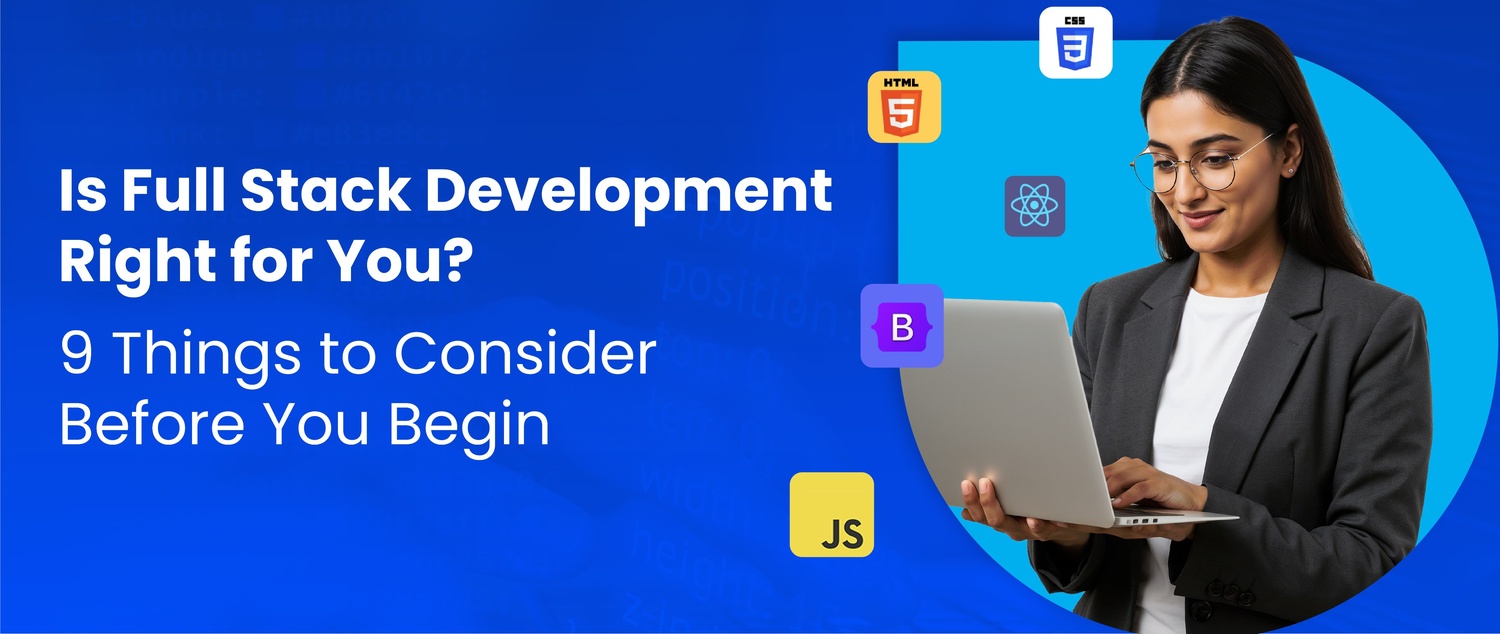The apps you use daily, such as Zomato, Myntra, and Instamart, as well as websites like Google, YouTube, and Facebook, are built and maintained by large teams of professionals. Among those professionals, full stack developers also play a crucial role in creating and shaping the front-end and back-end of these apps and websites.
Hence, the field of full stack development is more fascinating and innovative in this digital era, as startups and unicorns are increasingly inclined towards apps and websites to deliver their services and products to customers. This is where the high demand for full stack developers lies.
To support this, Stack Overflow 2025's report says that,

Hence, this role is evolving and growing rapidly, creating many job opportunities for individuals interested in building websites, apps, APIs, and other web-based services and products.
This blog will help you understand whether this field is the right fit for you as a fresher and also for professionals considering a career switch.
Before diving in, let us quickly understand what full stack development actually is.
- Full stack development is the practice of building both the user-facing interface and the behind-the-scenes systems of an application or a website.
- It spans front-end work (layouts, components, accessibility, performance) and back-end work (APIs, business logic, data storage, security).
Note:
- Front-end development is not the same as UI/UX design.
- UI/UX focuses on user research, layout planning, design systems, and prototyping using tools like Figma or Adobe XD.
- Front-end development focuses on turning those designs into functional web pages using HTML, CSS, JavaScript, and frameworks such as React.
- A full stack developer designs, implements, and integrates these layers so that features move from idea to a working, deployed product.
- Day to day, they write and test code, connect databases and services, manage deployments, and troubleshoot issues across the stack.
- They also collaborate with designers and product teams, make technical trade-offs on cost, speed, and reliability, and own end-to-end delivery.
Learning full stack development can be exciting, but it also needs some initial preparation. Before starting a full stack journey or joining a course, it's essential to ensure you have the basic skills and mindset required to enter this field. A simple pre-checklist, like the one below, will help you feel ready and confident as you begin your journey.
Pre-Checklist to Enter Full Stack Development

1. Career Alignment and Goal Clarity
Understand what your strengths, interests, and the kind of work-life you want to have. Check if these aspects align with a career in full stack development. For instance, if you're interested in building web applications end-to-end — from structuring pages with HTML/CSS to writing logic that connects to databases — you're already there!
And if you want to learn full stack development, the training courses are available, which are typically 6-12 months in duration. Ensure you are ready for this dedicated learning journey. For professionals considering a career switch to full stack development, reflecting on long-term goals is truly essential.
2. Educational Background
Anyone can learn the skills and tools of full stack development if they have a strong interest in coding, websites, and app development. However, having a degree in CS, IT, or IS is an added advantage. If you don't have a computer or technology background, but are interested in website or apps development, you're still eligible to enter the field. For freshers, identifying these full stack developer prerequisites will help build confidence at the start.
3. Understanding How the Web Works
Before diving into full stack development, it would be helpful to have an understanding of how websites communicate. For example, how the browser sends a request and how the server responds. Knowing the basics of HTTP, APIs, servers, and databases will make learning full stack development smoother.
Having said that, you don't need deep technical knowledge at the start, but having clarity on how the internet delivers information gives you a strong foundation to build on. Also, the concepts, skills, and tools taught in a full stack developer course can be learn faster if you have this basic understanding. Additionally, being familiar with computer operating systems, having the ability to type quickly and clearly, and understanding networks will be a great start.

4. Interest in Website Development
Today, almost every business needs a website, which is why website development is in high demand. If you enjoy taking an idea and turning it into a working website or application from start to finish — handling both what the user sees and how the system works internally — then full stack development will suit you. Full stack developers don't just build pages; they build complete solutions that function end-to-end.
5. Interest In Coding
If coding excites you, then you're already moving in the right direction. If you like figuring out how features should work, writing code to make them run, fixing errors, and improving performance — that's a strong sign you'll enjoy full stack development. Having familiarity with languages like Java, Python, or JavaScript is helpful, but what matters most is enjoying problem-solving through code.
6. A Personal Laptop / System (Mandatory)
Just as a musician needs an instrument to create music, a coder needs a laptop to bring ideas to life. Owning a computer or a PC is a must to embark on this journey. You don't need a high-end machine to get started; any entry-level i5/i7 laptop with at least 8GB of RAM will suffice. Popular and reliable options include HP Pavilion, Dell Inspiron, Lenovo IdeaPad, or Acer Aspire — all suitable for learning and practising coding effectively.
7. Logical Thinking & Problem-Solving Mindset
A developer is responsible for translating users' problems into code using programming languages. Hence, there is a need to have the ability to reason and solve problems. However, you don't need to possess these skills from the outset; they can be developed over time through experience and proper guidance.

8. Basic Exposure to Java (Optional but Helpful)
In recent years, Java has become one of the favourite languages for back-end development. While not mandatory, having a beginner-level understanding will be quite useful before entering the domain. That said, all the programming languages you need to succeed in a full stack career will be covered in any well-designed full stack developer course.
9. Mindset Readiness
By now, you may have realised that becoming a full stack developer means learning a wide range of skills and tools, such as front-end and back-end development, programming languages and so on. Mastering these areas takes time and effort, and on average, at least 6 Months. So, prepare yourself to be a dedicated and consistent learner if you want to enter the field of full stack. For professionals considering a career switch to full stack development, mindset readiness is essential to manage both the learning curve and career transition.
Salaries for Full Stack Developers
Full stack developers' earning potential is impressive, due to their versatile skill set and impact. Take a look at the image below to understand the average salary across different regions.

To become a full stack developer, starting with a structured training course can be the right first step if you are genuinely interested in this field. Reviewing your strengths, interests, and long-term goals with other aspects we discussed here will help you understand the full stack course eligibility and make a better decision.






.jpg)


